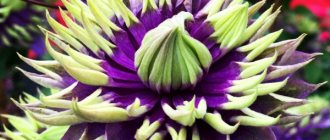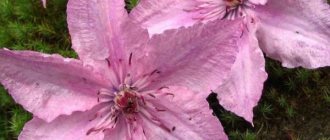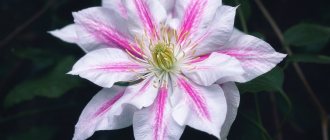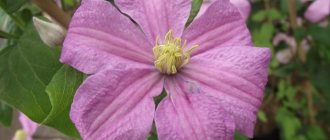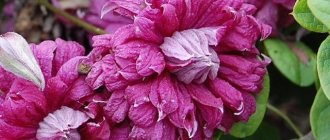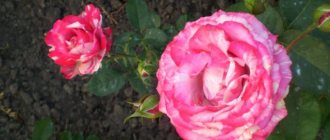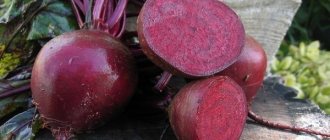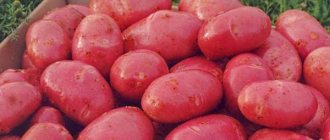Plants » Flowers
0
226
Article rating
Kira Stoletova
In Estonia, after a long selection work, the unusually beautiful clematis Piilu was finally obtained. In 1984, Professor Uno Kvistik was awarded several awards for this variety; the hybrid became popular in many countries around the world. In Russia, this clematis is grown everywhere, although it is a rather whimsical variety.
Clematis pilou photo
Description of the variety
The variety is compact, the shoots do not exceed 2 m in length, and in northern latitudes they grow only up to 90 cm. The flowers are medium-sized - 10-13 cm in diameter, pink-lilac in color with a dark pink stripe in the middle of each sepal. The anthers are long and bright yellow, slightly curled at the ends.
The flowering type of this hybrid is unusual. Terry buds are blooming on last year's shoots that have survived the winter. On young vines you can see simple, smooth flowers with regular petals.
Different buds bloom simultaneously on one bush, which looks decorative and original.
Double flowers consist of 25 petals, tightly curled, with a dark pink-lilac interior. The stamens are almost invisible. A simple flower has 6-7 sepals, they are elongated, light lilac, and the anthers are long and bright. The bush can bloom twice during the season - in May-June and then in September. It all depends on the conditions and climate, care and age of the bush.
Clematis of the Armanda group
Among the clematis of the first group of pruning, there are species that can rarely be found in our area, since they are particularly thermophilic and capricious in nature - these are Armand's clematis. However, this does not stop real fans, and they happily grow flowering vines in their plots. True, this is possible mainly in warm regions and with the condition of good shelter for the winter.
All representatives of Armanda are characterized by the following characteristics:
- the vines are evergreen, the leaves are dark and hard;
- vigorous bushes grow quite tall - from 5 to 9 m;
- early and abundant flowering;
- the inflorescences emit a faint odor reminiscent of a cross between the aroma of honeysuckle and black elderberry;
- winter hardiness is low (critical temperature for the plant is 12 degrees below zero);
- fragile shoots are difficult to cover;
- The bright midday sun is poorly tolerated by the vine.
Gardeners who are prepared for possible difficulties in caring for Armand clematis most often grow the Apple Blossom and Snowdrift varieties.
Clematis Apple Blossom
The liana can grow up to 6 m in height. It blooms very early, already at the end of March, but it decorates the garden until June. The inflorescences are small, somewhat similar to jasmine flowers, with a slight sweetish aroma, painted in a soft pink color, with yellow stamens.
Clematis Snowdrift
The shrub, 3 to 5 m high, is very decorative: against the background of dark green foliage, small pristine white inflorescences with a diameter of no more than 6 cm look beautiful. They bloom in March, but flowering ends at the end of May.
These are not all the clematis from the first pruning group; today you got acquainted with photos of clematis and descriptions of some of them. Their list can be continued for a very long time. Delicate light coloring, rich bright colors - look, admire and choose a colorful, abundantly flowering vine to suit your taste!
Landing Features
Due to its compactness, clematis Piilu can even be grown in a container. If you plan to keep it on the balcony, then you can plant it at any time of the year - autumn or spring. In a warm room it will survive both early autumn frosts and spring colds.
Clematis pilu reviews
In open ground, this plant dictates its own planting conditions. It is recommended to plant in autumn. Before real frost, the seedling has time to take root, get used to the microclimate of the environment and enter the dormant period without any problems. However, in the northern regions it is better not to risk it and plant young clematis in the ground in the spring. Over the summer it will strengthen without the risk of freezing, but it will begin to bloom a year later than during autumn planting.
Selecting a location
The Piilu variety is light-loving; the place for it should be well lit throughout the day. This is also important for the evaporation of moisture from the soil so that it does not stagnate at the roots. The flower is afraid of waterlogging, so it is advisable to choose a place for it on a hill. Lowland and shady areas are not suitable for this hybrid.
The southern and southeastern side of the garden, well warmed by the sun, without groundwater close to the surface, is an ideal place for planting. In other conditions, clematis, if it does not die, will grow poorly, get sick, and bloom rarely and for a short time. Only properly selected areas in the garden can fully reveal the potential of this amazingly beautiful variety.
Preparation of planting material
This hybrid is most often sold in foreign online stores, then sent by mail in a special container. Such seedlings must be carefully inspected before planting in the ground. They themselves may turn out to be unhealthy, there is a risk of introducing infection or parasites into the garden and infecting other flowers.
A healthy seedling is green, fresh, without spots or compactions on the leaves. The shoots should be clean, smooth, without traces of insects on the surface and in the axils of the leaves. When checking, special attention is paid to the roots. When transported in a container, they often dry out and wither. In this case, the seedling is placed in water for 8-10 hours before planting.
If, on the contrary, the roots of a young plant are waterlogged, you will have to work with them before planting. First, remove all rotten roots without damaging the central one. Then the cut areas are sprinkled with crushed activated carbon and kept there for 1-2 hours. Before placing in open ground, the roots and soil in the planting hole are sprayed with the fungicide Fitosporin-M.
Landing technology
The pit for each bush is prepared in advance, preferably a month in advance. If the planting is in spring, then it is dug up in late autumn. The main stage is organizing good drainage. This is important for the outflow of moisture from the roots of the plant so that they do not rot. Stones, expanded clay and large pieces of foam plastic are lowered to the bottom of the pit. 2-3 plastic tubes are also installed there so that later, when watering, the water will better nourish the roots.
After the drainage layer comes a layer of nutrient soil. It's easy to buy in the store, but then you still have to add a little. The soil should consist of:
- Leaf turf;
- Humus;
- Peat;
- Coarse sand;
- Compost.
The planting depth depends on the climate zone in which the flower will grow.
- In the southern regions, the seedling is dug in at a depth of 12 cm.
- In the north, the root collar should not be too deep - a maximum of 5-7 cm.
Important! Many inexperienced gardeners make the mistake of thinking that in cold latitudes it is more logical to plant a seedling deeper to protect it from the harsh winter. In fact, frost is not as bad for a plant as overheating in summer. In winter, with good and properly organized shelter, clematis will not freeze, but the hot sun can harm its root system.
Planting and caring for clematis Piilu
The plant is undemanding and picky. Planting and caring for the Piilu clematis variety does not cause any particular problems. You just need to consider a few points:
- Despite the fact that the flowers are light-loving, open space is not suitable for them, as the plant burns out.
- It is better to plant clematis in openwork shade.
- Low plants and lawn grass can be planted around the Piilu variety.
- Supports are installed next to single clematis of the Piilu variety; if planting is planned in a row, it is better to stretch a trellis or an openwork lattice.
Recommended timing
If we talk about the timing of planting flowers in a permanent place, then it is necessary to take into account the climatic conditions of the growing region. Gardeners in the southern regions begin work in the fall. As for Siberia and the Urals, it is best to plan planting of Piilu clematis in the spring, so that the seedlings of the variety have time to take root and adapt to the growing conditions.
Attention! Seedlings with a closed root system can be planted from spring to autumn.
Choosing a suitable location
Its further development and lush flowering will depend on where the Piilu clematis seedling is planted:
- openwork shadow and absence of drafts;
- when planting near the fence, you need to retreat 20 cm, from the wall of the house - 40 cm, so that rainwater does not fall on the bushes;
- groundwater should not be close to the surface;
- the soil is light and loose, fertilized with humus or compost.
Selection and preparation of planting material
Before planting, you need to inspect the seedlings. The leaves and shoots of clematis Piilu should be free of traces of diseases and pests. You need to choose bushes with a strong root system.
In order for the plant to quickly take root in a new place, a seedling with an open root system needs to be slightly revived - soaked in any growth stimulant. Bushes grown in containers are watered before planting.
Important! You should not save money when buying seedlings of the Piilu variety; it is better to use the services of trusted sellers or purchase clematis in nurseries.
Landing algorithm
Features of planting the clematis variety Piilu:
- Dig holes measuring 50x50x50 or 70x70x70 depending on the size of the root system at a distance of at least 80 cm.
- Place drainage at the bottom, fertile soil on top, and fill with water.
- Make a mound in the center and install a support.
- Dip the seedling in clay mash and dry slightly.
- Place clematis on a hill, straighten the roots.
- Sprinkle with soil, lightly compact and water.
- Tie the bush to a support, placing a piece of fabric or foam rubber between the stem and the cord so that the bark does not peel off.
- Mulch the root zone with dry grass.
- Experienced gardeners advise planting the soil around clematis Piilu with calendula, decorative moss, and lawn grass to protect the roots from overheating.
Comment! When planting clematis of any variety, the lower bud is buried 8 cm, then even if it freezes, the plant will not die, since the buds will sprout.
Care
The Piilu hybrid is considered high maintenance. However, the result is worth it - the lush flowering of clematis twice a year will not keep you waiting. Large terry buds will decorate any garden if you learn and fulfill certain requirements.
Clematis piilu description
Watering
It is necessary to water abundantly, especially in summer. However, this is only possible with well-organized drainage, otherwise the roots will quickly rot. You need to take settled water, preferably rainwater.
5-7 liters of water are poured under a first-year seedling every 4-5 days, and at least 20 liters under an adult bush.
In hot weather, the procedure is carried out more often, every 2-3 days, so that the roots do not dry out.
Due to lack of moisture, the plant may drop its flowers and not bloom again this year.
Top dressing
The Piilu variety is demanding when it comes to feeding; it needs a lot of nutrients for lush flowering.
Scheme:
- Early spring. Mineral complexes with a high nitrogen content are added - ammonium sulfate or carbonate, ammophosphate, sodium, ammonium, potassium nitrate, urea (urea).
- May-June, during the formation of buds, Clematis is fed with phosphorus-potassium complexes for decorative flowering plants.
- August-September, after flowering. They add organic matter - rotted mullein or bird droppings. Keep the amount of nitrogen to a minimum to prepare the plant for winter.
Throughout the year it is necessary to fertilize clematis with folk remedies. For example, herbal infusions are good for feeding flowering bushes. This is the same compost, only “quick preparation”. It takes only 1-1.5 months to bring it to full readiness.
In a large plastic or wooden barrel you need to chop various herbs (nettle is very rich in useful substances) and fill it to the brim with water. To speed up the process, add 1-2 tablespoons of urea. After 3-4 weeks, the starter is used to water garden plants. Fermented grass is sometimes spread around the bush as mulch.
Mulching and loosening the soil
All clematis have shallow roots and require oxygen for normal development. Therefore, the soil under them needs to be loosened after each watering, even after rain.
Clematis piliu planting and care
Mulching is also an important procedure. Mulch makes the top layer of soil loose, porous, and airy. It protects the roots from overheating and maintains a normal level of humidity, and also prevents the roots from freezing.
Hay, chopped wood, and non-coniferous sawdust are used as mulch. Clematis responds very well to placing tea leaves or coffee grounds on top of the soil under the bush. This is mulching and fertilizing at the same time.
Trimming
Hybrid Piilu belongs to pruning group II. The process takes place in two stages:
- In summer, shoots with faded flowers are removed. If there were too many buds, the vine is cut to the ground.
- In late autumn, all young shoots are cut down to 3-4 buds, 10-15 cm from the ground.
The degree of pruning depends on the age of the bush and how early flowering is desired. In order for clematis to bloom earlier, it is necessary to remove only the flowering fragments of the stems. If we are talking about more luxuriant, but late flowering, it is necessary to carry out a moderate or even complete haircut.
Aftercare for clematis Piilu
Caring for clematis Piilu is no more difficult than caring for other garden flowers. All events are identical:
- watering, fertilizing, loosening;
- pruning and pinching;
- protection from diseases and harmful insects;
- mulching the soil and preparing plants for winter.
Watering
Clematis does not tolerate drought well; soil moisture must be constantly maintained. If the winter was dry, then water-recharging irrigation is carried out early in the spring, then the plantings are not watered until the onset of summer.
In dry and hot weather, watering is carried out 1-2 times a week. 1-4 buckets are poured under each Piilu clematis bush in the evening. Use only warm water.
Top dressing
Immediately after planting, you don’t have to worry about feeding clematis Piilu. As a rule, it starts from the 2nd year of cultivation. The plantings are fed with mineral and organic fertilizers in 4 stages:
- at the beginning of the growing season;
- during the period of bud formation;
- during the first wave of flowering;
- before sheltering for the winter.
In addition to special fertilizers, chicken droppings, manure, and wood ash, hybrid clematis Piilu, according to gardeners, responds positively to watering with liquid in which meat and fish were washed.
Mulching and loosening the soil
Since the plant has low drought resistance, the soil must be mulched to retain moisture. If no other flowers have been planted, then it is advisable to spread withered green grass and straw over the entire surface.
Support
A support to support the vine is installed at the time of planting the plant in open ground. During the first years of life, clematis is directed in the right direction and, if necessary, the vine is tied up at new levels. As soon as clematis develops its root system, the plant no longer needs additional fixation and covers any vertical support on its own.
Source
Trimming
Gardeners who have been engaged in the crop for more than one year indicate that lush flowering of clematis variety Piilu can be achieved, given that it belongs to pruning group 2. Pruning should be gentle; activities are planned for the fall. The height of the shoots left can be arbitrary, but it is optimal to leave from 50 to 100 cm, depending on the length of the shoot.
When rejuvenating pruning, only strong and healthy lashes are left, the rest are removed.
You can stimulate lush double flowers on clematis Piilu (on shoots older than 1 year) by pinching. The first time the operation is carried out at a level with a bush height of 20-30 cm, the second - 50-70 cm. The third time the plant is shortened when the vines reach the maximum height.
Preparing for winter
The Piilu variety, according to gardeners, requires preparation for winter adversity. Choose a dry day for work:
- first remove unfallen leaves;
- then carry out sanitary and formative pruning;
- water the bushes at the roots if autumn is dry;
- spray the bushes of the Piilu variety and the root collar with copper sulfate, sprinkle the surface with wood ash;
- The root system is covered by pouring a bucket of dry compost or humus under the plant.
Sheltering shrubs for the winter
In the south, bushes do not require special shelter. In Siberia and the Urals you will have to work hard in the fall:
- sand is poured onto the compost pile;
- the lashes are removed from the support, carefully tied with twine, and bent to the ground;
- spruce branches or dry leaves and a layer of soil of at least 25 cm are piled on top;
- covered with a wooden box, which is pressed down with a stone.
In this state, clematis variety Piilu will remain until spring.
Source
Preparing for winter
It is important to exclude mineral complexes so as not to provoke the growth of the bush at a time when it already needs to rest.
Shelter is required even in warm regions.
Before the first real frost, the bush is pruned and covered. First, all the leaves are removed, then dry coniferous spruce branches are laid out under the bush and the plant is laid on it. Sprinkle dry leaves on top.
Clematis is covered with non-woven material and wrapped in film. For reliability, place a sheet of slate on top. Sometimes they use boards, but when they get wet they become too heavy. After wintering, it is important to remove this entire structure in time so that the plant does not rot.
Description of clematis Multi Blue
Clematis of this variety belongs to liana-like plants, the shoots of which become woody over time. Its green shoots grow up to 2-2.5 m during the season. The shoots of the first year are thin and flexible, but at the same time quite fragile. This must be taken into account when tying vines to supports. As they grow, the shoots become denser and take on a brown color, while remaining flexible.
With the onset of heat, leaves immediately appear, which take on an elongated shape with a pointed tip. The foliage color is dark green. The leaves are large, up to 10 cm in length, matte, petiolate.
Bright blue flowers with a purple tint are formed on shoots that grew last and this year. Clematis Multi Blue belongs to the Patens group. These varieties always have double or semi-double flowers.
Multi Blue has many petals, they are arranged in two circles. The outer ones have a rounded-oblong shape, veins and pointed tips. The petals are flat, slightly pubescent on the underside. Their number can be variable, from 6 to 8 pieces.
The inner circle of the flower has several rows of petals. They differ from the first ones in shape and size, which emphasizes the splendor and originality of this variety. Short petals, shaped like lancets or needles, are arranged vertically upward. Most often the central petals are a soft blue, but some variations from white to soft pink are possible.
In the center are the stamens, colored in various tones of light green, yellow, or white, depending on the stage of formation and opening of the bud. A flowering bush of the hybrid clematis variety Multi Blue is shown in the photo.
Interesting fact!
Multi Blue is considered a hybrid clematis. For this reason, the flower of the vine is quite large - up to 18-20 cm in diameter.
The flowering period of clematis Multi Blue begins quite early. In the first half of May, the first buds form and bloom on clematis bushes. After the first period of flowering, when the shoots of the current year grow, the second stage of violent flowering begins. In the absence of negative temperatures, it can last from May to September, giving flower growers the opportunity to enjoy this beauty every day.
The root system of Clematis Multi Blue is located close to the soil surface, which is very different from other varieties. The shrub forms many small, rather thin roots. Therefore, when growing clematis Multi Blue, you should not loosen the soil under the bushes so as not to destroy the plant. Instead of loosening, you can only mulch the soil.
Information about the frost resistance of clematis Multi Blue is contradictory. Some sources claim high resistance to low temperatures. Others characterize it as a shrub with low frost resistance. The hybrid is resistant to frosts down to –15˚С, but may not tolerate prolonged frosts. However, according to reviews from flower growers, the clematis variety Multi Blue successfully survives short-term temperature drops of –30˚–34˚С.
On a note!
This variety of clematis can be successfully grown on balconies. They decorate hedges and fences. In the flowerbed it goes well with yellow and white annuals and some low shrubs and conifers.
Based on the description, clematis Multi Blue belongs to the second pruning group. Last year's shoots are removed immediately after the end of the first wave of flowering. For the winter, all vines are pruned at a height of 1-1.2 m.
"Pros and cons"
Before planting Clematis Multi Blue on your site, you should familiarize yourself with its advantages and disadvantages in order to fully appreciate whether this wonderful plant can grow and delight you with its lush and picturesque flowering. The obvious advantages of this variety include:
- decorative characteristics of clematis Multi Blue;
- compactness of the vine;
- unpretentiousness to growing conditions;
- disease resistance;
- fairly high frost resistance;
- very lush and beautiful flowering;
- long flowering period.
The only downside is the need to prepare and cover the bush for winter.
Reproduction
Clematis Piilu is an artificially bred hybrid. It is easy to propagate in any way, but not in all cases it will retain its varietal properties.
The seed method does not make sense; it is better to resort to cuttings, propagation by layering or dividing the bush.
Cuttings
Cuttings are harvested in early spring, before buds open, cutting them from vines 2-3 years later. Each cutting should have 2-3 live buds. The planting material is placed in a solution of a root formation stimulator for several hours, and then placed in the substrate.
Clematis hybrid piilu
You can plant cuttings in flowerpots at home or place them in a greenhouse on your property. The second option is preferable; the plant will immediately adapt to the conditions of the garden, and will be subject to less stress when transplanted.
The substrate should be as light and breathable as possible. Approximate composition:
- Garden soil;
- Perlite;
- Vermiculite;
- Peat;
- Coarse sand.
The cuttings are placed in the soil at an angle of 45%, so more roots will form. At a temperature of +25-27 °C, rooting is fastest - after 2-3 weeks. At first, it is better to light the seedlings so that they actively begin to grow.
Layerings
This method is suitable for dividing an adult bush - from 5 years old and older. The outermost vines are bent to the ground and placed in dug grooves so that the top sticks out. The buried area is generously watered with Kornevin solution. Under favorable conditions, the first roots on the vine will appear in 3-4 weeks.
It is possible to separate the rooted cuttings in the fall, planting them in a permanent place. However, it is better to leave it untouched until spring. The mother bush will nourish the cuttings in late autumn and winter, helping to survive the harsh times. In the spring, when the young shoots wake up, they are separated and planted in pre-designated places.
Dividing the bush
This method ensures that the plant retains its varietal properties. However, it is quite labor-intensive and requires experience. In the fall, the bush is dug up completely, then the roots are separated with a sharp knife. The old, main root is placed in its original place, and the young shoots are planted separately.
The cut areas on the roots must be treated with a solution of potassium permanganate or Bordeaux mixture to prevent fungus from developing. You can soak the roots in them for 30-40 minutes. When planting, it is important to maintain a distance between bushes of at least 1 meter. Otherwise, the plantings will be too thick and the clematis will not bloom.
Trimming process
Pruning is especially important for all clematis, in particular for clematis Piilu. According to the pruning method, all clematis can be divided into groups:
- The first group of pruning - almost no pruning is needed. Only withered flowers and dried stems are cut off. Periodically, namely once every few years, “rejuvenating” pruning is carried out, that is, very low pruning. This group includes the varieties Atragena and Montana, whose inflorescences bloom only on last year’s shoots.
- The second group of pruning - in early spring, clematis are pruned 1.5 m from the ground to strong buds. These are varieties in which both new and last year's shoots bloom. These are Gypsy Queen, Crimson Star, President, Ashwa and Piilu.
- The third group of pruning is the easiest to care for. Pruned in early spring before active flowering begins. Cut 30-40 cm from the ground to strong buds. These are the varieties Jackmany and Rekta. Only new shoots bloom on them.
There is no specific cutting height. Some talk about 0.5-1 m, others about 1-1.5 m. There is no clear meaning. Each Piilu can have its own cutting height. If it needs to be rejuvenated, then it should be pruned to the maximum, and weak and affected shoots can be removed altogether.
Pinching is also important for clematis. The first pinching can be done when the plant has grown to 10-20 cm. The second when the shoots reach 50-70 cm, the third - 1-1.5 m.
Diseases and pests
The main reasons for decreased immunity of clematis are overwatering, lack of nutrients, improper pruning and replanting, and freezing in winter.
Clematis piilu
The most common diseases and methods of treatment:
- Powdery mildew. Immediately treat with fungicides - Topaz, Acrobat, Skor.
- Gray and black rot Effective fungicides - Alirin-B, Gamair, Diskor.
- Wilting (fusarium). Fungal disease is treated with Fundazol, Epin, Phytocid.
- Rust. Burn the affected leaves and shoots, treat the plant with 1% copper sulfate, Kuproxate (copper sulfate).
- Brown spot. Treat the bush with copper preparations - Benlat, Tsineb, 3% copper sulfate.
Among the pests that attack clematis:
- Aphid. Wash off with a solution of tar soap, spray with Biotlin.
- Medvedka. Effective drugs: Medvetox, Thunder, Zolon, Grizzly.
- Caterpillars. Collect by hand. Treat the bush with lepidocide, bitoxibacillin, dendrobacillin.
- May beetle larvae. They do not tolerate excess nitrogen in the soil. Fertilize the bush regularly in the spring with nitrogen-containing complexes.
- Slugs. Place cabbage leaves under the bush and collect them by hand in the morning. Sprinkle the soil around the bush with crushed eggshells.
Reviews about the variety
Gardeners speak positively about clematis, even though it is difficult to care for, often freezes in winter and does not retain varietal properties when propagated by seeds. It is grown even in the northern regions, where, although it freezes slightly, it still sprouts new shoots every year and blooms profusely.
Clematis pilu reviews
The hybrid is beautiful. There are so many flowers on the bush that the greenery is almost completely invisible. The bushes are compact, which allows them to grow in containers in any part of the house or on the balcony.
The Piilu variety can begin to bloom in the second year; it is a real decoration of any space. Lush flowering twice a year, unusual double flowers, long life of the bush - all this will be a reward for the gardener who decides to have this hybrid.
Grow clematis from seeds
Propagation by seeds has an advantage over all breeding methods, as it makes it possible to obtain any desired variety. I will describe in detail the cultivation of Piilu from seeds.
The seed method can be of two types: home (seedlings in containers) and ground.
Experts say that seedlings grown indoors do not tolerate picking well. Better survival rate of clematis sown in open ground
Sowing in the ground takes place in two ways:
| Method 1. Autumn Applicable only for large-fruited seeds:
| |
| Method 2. Spring Before sowing, soaking in nutrient mixtures is used: · seeds are kept in contrasting temperatures (2 times for 12 hours in the refrigerator 0...+5 °C)$
|
